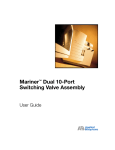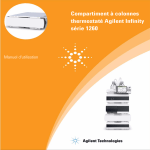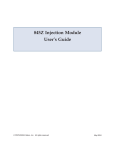Download Operating Instructions Models 7410 and 7413 Manual Micro
Transcript
® Operating Instructions Models 7410 and 7413 Manual Micro-Scale Sample Injectors 1.0 DESCRIPTION Models 7410 and 7413 are two-position, manual micro-scale sample injectors with an internal sample loop. These micro-scale injectors can inject between 0.5 and 5 µL of sample. Figures 1 and 2 show the flow diagrams of Models 7410 and 7413. Rotation of the handle 60° switches the valve from the LOAD position to the INJECT position. The dark grooves represent active flow passages and the dotted grooves represent inactive flow passages. Figure 3 shows the rotor seal and loop disc orientation of Model 7410. The loop disc contains two loops of tubing with different lengths. One loop is the sample loop, which fills during LOAD (between Ports 1 and 4) and injects sample onto the column in INJECT (between Ports 2 and 5). The other loop is the flow passage between Ports 2 and 5 when the valve is in LOAD. Ports 1 and 4 are off-line during INJECT (see Figure 1). Model 7413 loop disc and rotor seal accommodate a third loop. The loop disc contains three loops of tubing with different volumes. Each loop can be used as the sample loop. You must manually disassemble the valve and reorient the loop disc to change among the three different loop volumes. The active loop connects to Ports 1 and 4 during LOAD and connects to Ports 2 and 5 during INJECT. You can flush the valve with one of the inactive loops (shown in dotted lines) connecting Ports 2 and 5 in LOAD and Ports 1 and 4 in INJECT (see Figure 2). 2.0 SUPPLIED WITH THE VALVE • RheFlex® Stainless Steel Fittings sets for all ports • Hex Key(s) • Mounting Screw(s) The standard loop disc in Model 7410 contains a 1 µL sample loop. The standard loop disc in the Model 7413 contains 0.5-1-5 µL sample loops. Model 7413 is shipped with the 1 µL loop in the active position. 3.0 SPECIFICATIONS • Maximum Operating Pressure: 48 MPa (483 bar, 7000 psi) • Maximum Operating Temperature: 150°C • Flow Passage Diameters: 0.4 mm (0.016") • Wetted Surfaces: Stainless steel and Vespell 2 1 Pump 2 1 Pump Sample Sample Sample Loop Sample Loop Column Waste 4 Column Waste 5 4 Position A (LOAD) 5 Position B (INJECT) Fig. 1. Flow diagram of Model 7410. 2 1 Pump 2 1 Pump Sample Sample Sample Loop Sample Loop Column Waste 4 Column Waste 5 4 Position A (LOAD) 5 Position B (INJECT) Fig. 2. Flow diagram of Model 7413. 4.0 IMPORTANT NOTICES 4.1 Caution: Rinse the valve after using buffer solutions to prevent crystals from forming, which can scratch the rotor seal. 4.2 Caution: Do not mount the valve with the ports facing up. Any leakage may corrode the bearings. 5.0 INSTALLATION See Caution 4.2. Models 7410 and 7413 can each be mounted on a panel. Rheodyne offers two Mounting Panels with pre-drilled holes: Mounting Panel (P/N 7160) and Valve Angle Bracket (7160-010). a) Remove the handle by loosening the two handle set screws. Use the two screws supplied to fasten the valve to a panel. b) Replace the handle by centering the two set screw tips on the hole in the valve shaft. Tighten both set screws enough to hold the handle firmly. c) Connect the Loop Filler Port (P/N 7012) or Needle Port (P/N 9013) to Port 1 and a vent line to Port 4. Vent Line 4 must be at the same horizontal level as the injection port to avoid siphoning. Siphoning is often misinterpreted as a leak. d) Connect the pump to Port 2 and the column to Port 5. Leave the column disconnected from the valve during initial flushing. Stop Pins Rotor Pin Notch Sample Loop (in line with Rotor Pin) Loop Disc Rotor Seal Fig. 3. Rotor seal and loop disc orientation (viewed from the stator) in Model 7410. Model 7413 has the same orientation and accomodates a third loop. Page 1 of 2 2320167B 7/99 RHEODYNE, L.P. • P.O. BOX 1909, ROHNERT PARK, CA. 94927-1909, U.S.A. • (707) 588-2000 • FAX (707) 588-2020 www.rheodyne.com 6.0 OPERATION Using an excess of sample to load the sample loop of micro-scale sample injectors ensures that the sample loop contains only undiluted sample. This complete-filling method of loading uses the volume of the sample loop to set the volume of sample injected. The valve loads using an accessory Loop Filler Port or Needle Port with the injector. Model 9013 Needle Port is conveniently designed for minimal sample waste during syringe loading of the sample loop. Both Model 9013 and Model 7012 Loop Filler Port produce high reproducibility. To completely fill the loop and inject sample: a) Insert a microliter syringe needle into the Loop Filler Port or Needle Port while the valve is in LOAD. b) Load the sample with at least two to five loop volumes of sample. c) Leave the syringe needle in and turn to INJECT. 7.0 ADJUSTING FOR LEAKAGE OR HIGHER PRESSURE OPERATION If you need operation to a higher pressure or if there is a leak between stator and stator ring proceed as follows: a) Unscrew the three set screws partly out of the stator. b) Tighten each of the three stator screws 1/8 of a turn. Continue to tighten each screw until the leak stops and the valve holds the pressure you want. c) Confirm that the gap between the stator and stator ring is equal around the valve. When there is no leak, tighten the set screws until they touch the stator ring. Do not tighten the stator screws too tightly. Excessive tightening will increase wear on the rotor seal. If you need to loosen the spring tension (for lower operating pressure or to adjust for a new rotor seal), first loosen the stator screws then tighten the set screws. If there is still leakage at this new setting, repeat steps a-c of Section 7.0. Replace the rotor seal if leaks continue. See Section 10.0. Note: Vent Line 4 must be at the same horizontal level as the injection port to avoid siphoning. Siphoning is often misinterpreted as a leak and will stop when the loop and vent line are empty. 8.0 MAINTENANCE Genuine Rheodyne parts are easily replaced by following the instructions. The only parts that may need eventual replacement are the rotor seal and isolation seal. The main cause of early failure is abrasive particles in the sample that can scratch the rotor seal surface. The standard sample loop and rotor seal in Models 7410 and 7413 can be changed using the following instructions: 8.1 DISASSEMBLY To disassemble the valve, refer to Figure 4 and proceed as follows: a) Remove the three stator screws. b) Remove the stator and stator ring (not shown) from the body. c) Pull the rotor seal off the seal pins. d) Pull the loop disc off the rotor seal. e) Remove the isolation seal (not shown). 8.2 REASSEMBLY To reassemble the valve, refer to Figures 3 and 4 and proceed as follows: a) Mount the new isolation seal with open side facing the handle. b) Replace the loop disc on the handle side of the rotor seal (opposite side of the notch). The notch on the rotor seal should face the stator. Observe that the two ends of the desired loop are in-line with the notch on the rotor seal. c) Line up the notch on the rotor seal with the rotor pin (see Figure 3). d) Mount the rotor seal on the rotor. e) Replace the stator ring so that the two stop pins enter the mating holes in the body. The rotor pin must be between the two stop pins. f) Mount the stator onto the two pins on the stator ring. g) Put the three stator screws in place. Tighten each screw a 1/2 turn past fingertight. Confirm that the gap between the stator and stator ring is equal around the valve. Note: If the position of the three set screws has been changed it is best to back them out completely before tightening the stator screws. Follow step g above. Pressurize your system to about 3 MPa (35 bar, 500 psi) higher than your maximum pressure. Notch Rotor Pin Seal Pins Set Screws Stator Screws Rotor Loop Disc Stator If there is a leak, tighten each stator screw a 1/8 turn each until the leak stops. Now tighten the set screws until each touches the stator ring. 9.0 OPERATING SUGGESTIONS AND TROUBLESHOOTING 9.1 LEAKAGE If you see liquid between the stator and stator ring or Vent Line 4, tighten the stator screws as explained in Section 8.2. If the leak continues, then replace the rotor seal. Vent Line 4 must be at the same horizontal level as the injection port to avoid siphoning. Siphoning is often misinterpreted as a leak and will stop when the loop and vent line are empty. If cross-port scratches cause a leak, then the leak will continue as long as the pump is pumping. 9.2 USE OF AQUEOUS BUFFERS OR SALT SOLUTIONS To prevent the formation of salt crystals in the valve that can scratch the rotor seal, flush out the flow passages and injection port with water after using salt solutions. 9.3 USE OF HIGH pH SOLUTIONS The standard rotor seal in Models 7410 and 7413 is Vespell , a polyimide with good wear resistance. Vespel is sensitive to alkaline attack when exposed to solutions having a pH of 10 or more. Use a PEEK or Tefze1l rotor seal for alkaline solutions. 10.0 RECOMMENDED SPARE PARTS Rheodyne offers a RheBuild™ Kit for Model 7410. The RheBuild Kit includes all the necessary parts, tools, and instructions to maintain the quality performance of your valve without separate part ordering. 7410-999 RheBuild Kit for 7410 13.0 WARRANTY All Rheodyne products are warranted against defects in materials and workmanship for a period of one-year following the date of shipment by Rheodyne. Rheodyne will repair or replace any Rheodyne product that fails during the warranty period due to a defect in materials or workmanship at no charge to the customer. The product must be returned to Rheodyne’s factory in original packaging or equivalent, transportation prepaid. Damage occurring in transit is not covered by the warranty. This limited warranty is Rheodyne’s sole warranty of its products, and all other warranties of merchantability or fitness for any particular purpose are hereby disclaimed. Under no circumstances will Rheodyne be liable for any consequential or incidental damages attributable to a claimed failure of a Rheodyne product, even if Rheodyne has been placed on notice of possibility of such damages. Rotor Seal Fig. 4. Exploded view of Models 7410 and 7413. 1 Vespel and Tefzel are trademarks of E.I. DuPont Page 2 of 2 2320167B 7/99 RHEODYNE, L.P. • P.O. BOX 1909, ROHNERT PARK, CA. 94927-1909, U.S.A. • (707) 588-2000 • FAX (707) 588-2020 www.rheodyne.com


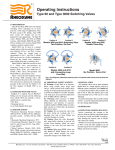

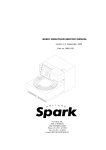

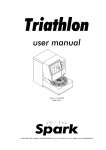
![TSQ Series Getting Started Guide Version C [FR]](http://vs1.manualzilla.com/store/data/006357565_1-ae930521dae4517a45cdbc191dde2ba3-150x150.png)
